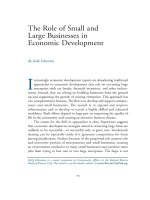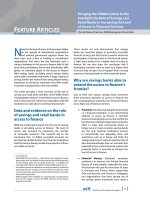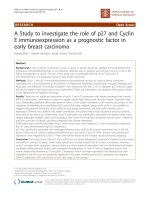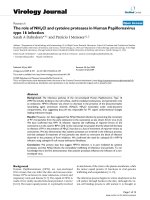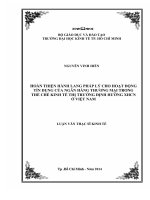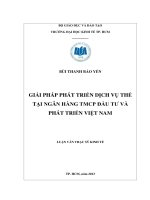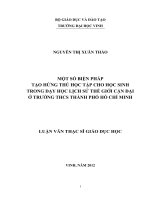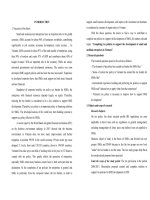The role of credit and monetary transmission in vietnam a var approach luận văn thạc sĩ
Bạn đang xem bản rút gọn của tài liệu. Xem và tải ngay bản đầy đủ của tài liệu tại đây (1.64 MB, 58 trang )
•
INSTITUTE OF SOCIAL STUDIES
THE HAGUE
THE NETHERLANDS
UNIVERSITY OF ECONOMICS
HO CHI MINH CITY
VIETNAM
VIETNAM- NETHERLANDS
PROGRAMME FOR M.A IN DEVELOPMENT ECONOMICS
THE ROLE OF CREDIT AND MONETARY
TRANSMISSION IN VIETNAM: A VAR
APPROACH
A thesis submitted in partial fulfilment ofthe requirements for the degree of
MASTER OF ARTS IN DEVELOPMENT ECONOMICS
By
NGUYEN LE THAO NGUYEN
Academic Supervisor:
Dr. NGUYEN VAN NGAI
HO CHI MINH CITY, May 2012
•
I
2
ACKNOWLEDGEMENT
•
I have deeply grateful to many people who support and advise me during the writing
this thesis. The thesis will not be complete without their assistance and encouragement.
My first thanks to my supervisor- Dr. Nguyen Van Ngai, who gave me valuable ideas,
comments, suggestions, and motivation during the preparation of this thesis. Thanks to
his friendly attitude and enthusiasm has given me more self-confident to complete this
study.
I sincerely thank Tutor- Mr. Phung Thanh Binh who provided me materials, also
economic techniques relevant to my thesis. I am grateful to all lecturers and tutors of
Vietnam-Netherlands Master Program in Development Economic, who have made
invaluable contributions.
I wish my express my special thanks to my friends Nguyen Van Dung, Le Anh Khang,
Vo Thi Ngoc Trinh. They have spent a lot of time and effort in helping me during my
writing.
Last but not least, I thankful to my lover, parents and brother who were always beside
me and gave me spiritual support.
3
ABSTRACT
•
Among different channels (namely: interest rate, asset price, credit, exchange rate
channel) are affected by monetary policy, which one plays as a key channel in this
mechanism. In this study, I investigate the role of credit channel in monetary
transmission mechanism in the case of Vietnam. Two different specifications of loan
markets are conducted: classical market (without domestic credit) and augmented
market (with domestic credit) to look for the evidences of the role of credit. Vector
autoregression model which focuses on the reduced form will be employed as main
econometric techniques in this thesis. The empirical results support that credit channel
plays important role in monetary transmission in Vietnam case. The correlation
between lending channel and monetary policy is somewhat weak. The policy
implication that credit sector should be carefully controlled when implements new
monetary policy.
Key words: domestic credit, credit channel, monetary policy transmission, VAR
model
•
4
LIST OF TABLES
•
Table 2.1: One decade and Vietnam's credit
Table 3.1: The data sources
Table 4.1: Description of variables
Table 4.2: Augment Dickey-Fuller test
Table 4.3: Philips- Perron test
Table 4.4: Optimal lap-Classical market
Table 4.5: Optimal lap- Augmented market
Table 4.6: VAR Regression Statistic- Classical market
Table 4.7: VAR Regression Statistic- Augmented market
Table 4.8: Variance Decompositions for vector autoregression for Classical and
Augmented Market
'
LIST OF FIGURES
Figure 3.1: Analytical Framework
Figure 4.1: The impulse response functions for classical market
Figure 4.2: The impulse response functions for augmented market
5
LIST OF ABBREVIATIONS
•
IFS-IMF: International Financial Statistic- International Monetary Funds
SBV: State Bank ofVietnam
OMOs: Open Market Operation
SOCBs: State Owned Commercial Bank
JSBs: Join Stock Bank
ADF: Augmented Dickey Fuller
PP: Philips-Perron
LR: sequential modified LR test statistic
FPE: Final prediction error
AIC: Akaike information criterion
SC: Schawarz information criterion
HQ: Hannan-Quinn information criterion
U.S: United States
6
TABLE OF CONTENTS
CHAPTER 1: INTRODUCTION ....................................................................................... 9
1.1
RELEVANCE AND BACKGROUND OF STUDY .......................................... 9
1.2 PROBLEM STATEMENT ..................................................................................... 10
1.4.RESEARCH QUESTION ....................................................................................... 11
1.6
STRUCTURE OF THESIS ................................................................................. 12
CHAPTER 2: LITERATURE REVIEW ...................................................................... 14
2.1 CREDIT CHANNEL THEORY ............................................................................. 14
2.2 MONETARY POLICY FRAMEWORK OF VIETNAM ..................................... 16
2.2.1 LEGAL FRAMEWORK .................................................................................. 16
2.2.2 MONETARY POLICY STRATEGY AND INSTRUMENTS ..................... 17
2.2.3 VIETNAM'S FINANCIAL MARKET OVERVIEW .................................... 19
2.3 EMPIRICAL LITERATURE .................................................................................. 21
3.1 ANALYTICAL FRAMEWORK ............................................................................ 27
3.2 MODEL SPECIFICATION .................................................................................... 28
3.3 DATA SOURCES .................................................................................................... 30
3.4 STEPS OF ESTIMATION ...................................................................................... 32
CHAPTER 4: FINDING AND DISCUSSION ................................................................ 34
4.1 DESCRIPTIVE STATISTIC .................................................................................. 34
4.2 UNIT ROOT TESTS ............................................................................................... 35
4.3 VARREGRESSION STATISTICS FOR CLASSICAL AND AUGMENTED
MARKET ........................................................................................................................ 37
4.4 IMPULSE RES PONES AND VARIANCE DECOMPOSITIONS .................. 40
4.5 RESULTS COMPARISON .................................................................................... 47
CHAPTER 5: CONCLUSION AND POLICY IMPLICATION ................................... 49
5.1 CONCLUSIONS ...................................................................................................... 49
7
5.2 POLICY IMPLICATION ........................................................................................ 50
5.3 LIMITATION AND FURTHER STUDIES .......................................................... 53
5.3.1 LIMITATION .................................................................................................... 53
5.3.2 FURTHER STUDIES ....................................................................................... 53
REFERENCES ................................................................................................................... 55
APPENDIX ........................................................................................................................ 58
•
•
8
CHAPTER 1: INTRODUCTION
This chapter will present how important of this study is, its objectives and research
questions. In addition, a brief of methodology is also mentioned in this chapter. Finally,
the scope and structure of thesis are deal with in this part.
1.1 RELEVANCE AND BACKGROUND OF STUDY
The restructuring of state owned commercial banks (SOCBs) and the establishment of
join stock banks (JSBs), had appeared since Vietnam financial reform in the first haft
of 1990s. Consequently, the finance system of Vietnam has deepened when
monetization increased continuously (in 2004, the ratio M2 to GDP was above
estimated 70% compare to 25% in mid-1990). Seventy-three percentage of total credit
is provided by SOCBs in 2004. The credit market and other parts of financial system to
be segmented proceeding. JSBs and others small banks supplied credit primarily to
private sector, whereas SOCBs almost loaned both sectors equivalently (Camen, 2006).
When Vietnam took part in the World Trade Organization (WTO), lead to the surge of
new foreign direct investment and portfolio inflows. Globalization, it's synonymous
with Vietnam has posed significant challenges to their economy. Unfavorable balance
of payments is also the major concern. Vietnam's financial sector has been explosion
since 2000 year only, noticeable in 2007-2008 periods. Consequently, Vietnam's credit
market grew too hot, the number was estimated about 50 percentage in January 2008,
that contributed a positive element to inflation rising, got 14 percentage at this time
(Ishii, 2008). And at early months of year 2011, Vietnam's inflation rate accelerated to
13.89 percent in March, peak out at highest in 25 months. Moreover, the trade gap
increased to $1.15 billion that month after look over $1.11 billion in February (S&P
Reporting, 2011 ).
•
9
1.2 PROBLEM STATEMENT
For facileness, most of economic models usually assume that the changes of economy
which affect by financial conditions have just relatively bounded by set of several
financial variables. They could be risk-free interest rates in short term or government
bond rates in long term (Hall, 2001 ).
However, once the system of financial develops with high degree, especially in recent
years, its impact on the economy becomes wider and deeper. Hence, it's quite hard to
find the root of problem when the economy is developed, because of some variables
may not be indicated. For example, the world financial crisis in 2008 had a root from
credit sector, typically, mortgage assets crisis in the U.S or the refugee capital of
Vietnam security market in 2008 due to the easing monetary policy in previous years.
In the past, many economists such as Pintinkin, Gurley, Shaw, etc., emphasized the
important role of financial intermediaries and credit markets. Modigliani and
Papademos (1977) also admitted that the traditional theory of monetary mechanism
ignored the functions of financial intermediaries and bank credits. Financial
intermediaries were strong influence on credit supply than money supply (Gurley and
Shaw, 1956). Evidently, credit channel contributes a significant factor and affects
directly to decisions of policy makers.
Hence, understanding the position of credit channel in financial market is crucial to
policy makers. In detail, understanding the transmitted mechanism of monetary policy
through credit channel is very important. As a result, indentify the role of credit
channel in monetary transmission is essential for enhancement current policies. By that
way, it contributes to the achievement of national economic objective.
10
1.3 RESEARCH OBJECTIVE
This study aims to identify the role of credit channel in Vietnam's monetary
transmission mechanism, specify 1996-2010 period. Following the main objective, the
thesis:
To analyze whether past value of credit helps predict the money supply;
To examine the impact of credit shocks on money supply, also other macro
economies;
To test whether credit shock plays important role in forecasting the error of money
supply.
1.4.RESEARCH QUESTION
To obtain the above objectives, this thesis will attempt to answer the following
questions:
Main question:
What is the role of credit channel in the monetary policy transmission in Vietnam case
over the period 1996-2010?
Sub questions:
Does the past value of credit help predict money supply?
How does money supply reaction to credit shock?
Whether credit shocks plays important role in forecasting money supply's error?
1.5 METHODOLOGY
To carry out above objectives, this study uses quarterly data from 1996:Ql to 2010:
Q3. Econometric techniques and descriptive statistic will be employed as primary
quantitative in this research.
11
Descriptive statistic analysis gives an overview of all variables that are used in this
thesis. Those are including: the distribution, variation, central tendency of all original
also changed data. Since then, we can a cursory evaluate the quality of employed data.
Concerning to the econometric techniques of time series data, vector autoregression
(VAR) will be employed to answer key questions. Due to the data is time series, unit
root test is used to examine for stationary of all variables to ensure the validation ofttest and F-test in firstly. Next, optimal lag lengths for VAR model is chosen by
different criteria to have the best model. Granger causality test will help us answer first
sub question whether past value of credit is useful to forecast money supply. Then,
impulse responses and variance decompositions are two popular techniques of VAR
model to answer two last sub questions respectively. Collecting from those empirical
results, we can conclude the role of credit channel in monetary transmission in
Vietnam case.
1.6STRUCTURE OF THESIS
The study is organized as following:
Chapter 1 introduces the importance of thesis, relevance and back ground of study, the
objectives and research questions. And the methodology is presented as briefly in this
part.
Chapter 2 demonstrates the literature review. Firstly, credit channel theory is
mentioned as a core of study. Secondly, empirical studies about the role of credit
channel in monetary policy transmission are presented. In addition, the chapter gives
overview the Vietnam's monetary policy framework, in which focuses on the credit
market.
12
Chapter 3 presents analytical framework, then develop the model which helps us
answer key question. Finally, data description as well as steps of economic techniques
will be mentioned in this chapter.
Chapter 4 shows the empirical results and discussion. Finally, results comparison is
also presented in this part.
Chapter 5 give conclusion, suggests some practical policy implications, and discusses
the limitations and direction for further studies.
13
CHAPTER 2: LITERATURE REVIEW
In this part will be described theories applied in thesis as briefly. Next, the framework
of monetary policy in Vietnam is presented in this part. Besides that, some remarkable
empirical studies regarding to the role of credit in monetary transmission in other
countries, also in Vietnam will be introduced.
2.1 CREDIT CHANNEL THEORY
Credit channel theory is based on the existing of external finance premium, reflected
typically by principal agent problem between lender and borrower. Bernanke and
Gertler (1995) had discussed in some details through two possible linkages, these are
the bank lending channel and the balance-sheet channel. This thesis will mention two
linkages which are relevant to credit channel theory.
The bank lending channel: concentrates the variability of loan supply through deposit
institutions caused by the effect of monetary policy actions.
Banks, that remain dominant information sources in the economy, so that, can
overcoming asymmetric information problems and other fictions in credit markets.
That is a reason why many borrowers depend on bank credit, specially small and
medium size enterprises. Once this function still remains, the influence of bank lending
channel in monetary policy transmission continues its role.
In case, the government does expansionary monetary policy, bring to increases the
bank deposits from customers or bank reserves; the quantity of bank loans available
would be increased, then investment increases, lead to output increases.
Conversely, tightening monetary policy is synonymous with reducing bank reserves or
customer deposits, which leads to a decreased of quantity of bank loans available.
Next, reduce investment spending and output decrease as consequently.
14
Another side of credit view, when we mention to the impact of monetary policy to
enterprises, small firms suffer bad effects on expenditure than large firms (Mishkin,
1996). The reason is because of more dependent on bank loan with small companies,
whereas big companies can access huge capital through stock and bond markets, not
necessary via bank channel.
Balance sheet channels: focuses influence of monetary policy changing on borrower's
balance sheets and income statement.
In balance sheet aspect, the changing in company's worth due to the variability of
monetary policy tends to raise the adverse selection and moral hazard problems when
grant loans to those companies. The borrowers have less collateral in case, the
probability moral hazard problem happen will high if those firms want to access the
loan. More details, the company with lower equity prices has tendency to accept risky
projects. Then, the more risky the firms take, the more probability the firms could not
paid back their loans, which leads to bank collapsed and decreased in lending, and also
investment spending.
Meanwhile, the banks request the lenders provide more
collateral for their crediting due to net worth declining, hence have an increase the
adverse selection problems, and reduce fund for investment as consequences.
Here is several ways which monetary policy acts upon on firm's balance sheet:
Expansionary monetary policy, as already dealt with earlier, is the reason of rising in
equity stake. In this circumstance, adverse selection and moral hazard problems were
decreased as well. Next, firm's valuation will increase and the sources of capital, which
provide for investment, are also higher and lead to increasing in aggregate demand.
In other way, lower interest rates by the reason of expansionary monetary policy also
cause the firm's balance sheet reformation because of the effect of cash flow.
Therefore, adverse selection and moral hazard problems can be lessened. As a result,
15
capital available for loan will increase, investment spending growth, aggregate output
increment finally.
Monetary expansion is the reason which brings to the unforeseen increase in the price
level, hence raises the net worth of companies and lower adverse selection and moral
hazard problems. It implicates a rise in investment spending and aggregate output.
On the other hand, contractionary monetary policy causes a decline in equity price or
reducing in cash flow. Therefore, a lower net worth of business firms because of the
increase of adverse selection and moral hazard problems, in tum decrease leading to
financing investment and consumption.
2.2 MONETARY POLICY FRAMEWORK OF VIETNAM
2.2.1 LEGAL FRAMEWORK
According to "Law on the State Bank of Vietnam", the SBV is a body of government
and the central bank of the Socialist Republic of Vietnam. The Law also stated that
National Assembly and the government are responsible to give decisions, also its
supervisor relevance to monetary policy. The government has function to prepare a
plan, including projection annual inflation rate for monetary policy. It determines the
amount of liquidity which to be injected in the economy. The government has to report
the progress on implementation of monetary policy to National Assembly. The role of
SBV includes exercise monetary policy, as designed by government. In addition, the
SBV will conduct the state's management through monetary and bank activities and act
as currency issuing bank, bank of credit institutions, and bank of government. Those
activities have goal to stabilizing the currency value, preserve banking activities and
banking system, and adapting with state budget and economy growth within the
context ofthe country's socialist orientation (State Bank of Vietnam, 2003).
16
Base on SBV Law, SBV operates as a part of Vietnamese government, while the
National Assembly plays an important role in monetary decision. A strong intervened
of government; also National Assembly in the implementation money policy exhibits
that the limited ofSBV's independence instruments (Camen, 2006).
2.2.2 MONETARY POLICY STRATEGY AND INSTRUMENTS
The Vietnam's monetary policy strategy is extracted from five years plan of Social and
Economic Develop Strategy. And the government has duty to formulate the action plan
for implementation. Not only the targets for injection of liquidity into the economy are
set, but also M2, credits, deposit and other target related will be determinate as
important part of government's action plan (Camen, 2006).
The SBV, as a part of government, bases on macroeconomic and monetary objectives,
announces annual targets for total liquidity and credit to the economy. Each year, the
SBV arranges a report the implementation monetary policy of that year and monetary
outlook for next year. Then, the SBV submits it for the government consideration and
approval. Finally, government will submit this report to National Assembly for
approval, after consulting with National Monetary Policy Advisory Board 1 (Hung and
Pfau, 2008).
Regarding to monetary instruments, a number of indirect tools have been introduced
include reserve requirement, refinancing, discount financing facilities, open market
operation and foreign exchange interventions.
Reserve Requirements
SBV has applied reserve requirement in various forms since 1990s. This instrument
proves its important role on money market regulating in past. Currently, required
1
National Monetary Policy Advisory Board (NMPAD): is broad including the Governor ofthe State Bank, the
Minister of Finance, and other experts.
17
reserves are distributed into classes depend on deposit maturity, the sectoral focus of
bank, and the kind of currency deposits (domestic or foreign currency). Deposits of less
than a year are higher than those for more than a year and interest subsidized for banks
when credit for agriculture sectors or People Credit's Fund (Camen, 2006).
In 2008 year, reserve requirement was used as an effective tool in order to constrain
inflation due to strong economic and monetary movements both domestically and
internationally. On February 2008, the SBV raised the reserve requirement ratio by 1
percentage point applicable to both local and foreign currency deposits in most of
credit institutions (SBV, 2008). In recent years, with goal to prevent economic down
tum, the SBV decreased required reserve applicable to VND deposit for below 12
months twice in 2009 from 6% to 5% and to 3%, exception for Vietnam Bank for
Agriculture and Development reduced this rate from 3% to 2% and 1% (SBV, 2009).
In 2010 year, SBV continued to keep reserve requirement ratio at low level; in specific;
3%, 1% for VND deposit below and more than 12 months respectively. For foreign
currency, SBV also adjusted down to help credit institution increase foreign currency
funding (SBV, 201 0).
Open Market Operations (OMOs)
OMOs have been used by State bank since July 2000. Over those years, this instrument
proves its importance and becomes a single most significant monetary instrument for
controlling liquidity. OMOs were flexibly managed in line with other monetary policy
instruments, thus helping to stabilize the money market. SBV conducted by issuing
SBV's compulsory bills, higher base interest rate, in particular, increasing 182-day and
364-day bills with the annual rates of7.5% and 7.75% respectively for sake of inflation
control at first 7 months of 2008 (SBV, 2008). The first half of 2009, SBV had offered
to purchase valuable papers for maturity 14-days, that supplied short-term capital and
facilitated credit institutions to meet capital need for economic stimulus programs
18
(SBV, 2009). However, this action of SBV was unsuccessful because of low demand
of fund and surplus financial resources at that timing. Continuity, OMOs were
conducted to support credit institutions in first 9-months of 2010 by purchasing
valuable papers, but increased interest rate for those papers due to high inflation
pressure at 3-months end of2010 (SBV, 2010).
Discount Policy
Besides changing reserved requirement, a refinancing and a discount facility are
another tool ofSBV's discount policy. The form of refinancing rate and rediscount rate
are fairly similarly. However, rediscount rate is set by SBV that base on collateral
valuable papers such as draft, promissory note, bond .. etc. Commercial banks use those
valuable papers as collateral to access funds form SBV. While refinancing rate is given
rely on commercial bank's loan by SBV. Commercial banks use those loans as
collateral for their loan from SBV. Because of this difference, refinancing rate is
usually higher than rediscount rate in practical.
Recently, the SBV has used
refinancing rate as a mean of supplementing ensure short term lending and liquidity to
credit institution in 2010. SBV provided mainly 1 to 2 months refinancing to guarantee
liquidity of economy. And at late 2010 year, the SBV conducted refinancing in order to
promptly adapting the high demand for deposit withdrawals of economic organizations
and individuals during Lunar New Year (SBV, 2010).
2.2.3 VIETNAM'S FINANCIAL MARKET OVERVIEW
Historically, only the SBV and two SOCBs provided almost all financial services for
Vietnam's financial system. In 1988, two years after Doi moi, the SBV was separated
and operated as the central bank in which specializes in the monetary policy and
financial supervision. Next step of financial reform is appearance of join stock of
19
,
commercial banks and foreign banks in 1991, 1992 respectively. To fulfill policy
finance, Development Assistance Fund was established in 2000 year. Vietnam's
financial market connects closely in non-commercial lending in past, in which
agriculture sector dominance (World Bank report, 2006).
In the World Bank's report related to the state of Vietnam's capital market in 2006
commented that Vietnam's banking sector had expanded rapidly, mostly by supplying
loans to private sector. SOCBs still remain dominant for credit to economy. Despite of
sector reform, the banking sector remains financially weak and requires reinforcement
to enhance its stability and lending capacity (World Bank report, 2006).
Table 2.1: One decade and Vietnam's credit
-
2000 2001 2002 2003 2004 2005 2006
Credit to
Economy (tril.)
Credit to
Economy
(growth rate)
GDP (tril.)
Credit to
Economy(%
GDP)
2007
2008
2009
443
598
734
1,100 1,404 2,040 2,690
23% 25%
32% 39%
35%
23%
50%
28%
45%
32%
442
481
536
613
715
839
974
1,144 1,485
1,658
1,981
35%
40% 45%
52%
62%
71%
75%
96%
155
191
240
318
95%
123% 136%
Source: Calculated from IMF-IFS and GSO data
In the banking sector credit, credit to the economy rose from VND 155 trillion in 2000
(35 percent GDP) to VND 2,690 trillion (136 percent GDP) in 2010 (as shown table
2.1 ). Only one decade, the supplied credit increased seventeen times. Noticeable,
Vietnam's credit growth was too fast since late 2007 (50 percent credit's growth). This
phenomenon could be explained by a massive capital inflows and real estate price
•
2010
bubbles as collateral loan (Vietnam Plus News, 2009) .
20
Vietnam's credit growth 2011 and orientation in 2012
According to Reuters Article, total outstanding loans in Vietnam's banking system
grew 10.9 percent last year from 2010. That is a lowest rate of credit growth in one
decade recently. This number was well smaller than a target 15-17 percent, which had
been cut under 20 percent initially in 2011 year. Meanwhile, deposit growths 8.89
percent from 2010 and money supply expanded an estimated 9.27 percent in monthly
report ofSBV.
Vietnam is targeting credit growth at 15-17 percent this year and a 14-16 percent
increase in money supply (Reuters News, 2012). Monetary policy will be used by
Central Bank to meet a credit growth. Nguyen Van Binh, the Governor ofSBV, quoted
in December lending growth could stay below 15 percent. SBV continues to focus on
development of agriculture and rural sectors, production of goods for export, auxiliary
industries and to support small and medium-sized enterprises (Baomoi News, 2011).
Agribank, Vietnam's top lender by assets, is still chosen in fund disbursement, account
for 75-89 percent of its loans for agriculture and rural development. Further, central
bank has allocated various annual credit growth targets for domestic banks. For ranking
between zero and 17 percent, SBV divided banks into four groups, which have
maximum loan growth rate of 17 percent, 15 percent, 8 percent and zero percent
respectively (Reuters New, 2012).
2.3 EMPIRICAL LITERATURE
In recent years, many empirical studies related to the role of credit in monetary policy
transmission have been done. At beginning, Bemanke and Blinder (1988) were raised
this problem in famous paper "Credit, Money and Aggregate Demand". IS/LM model
21
as simple tool which they employed to measure variance of money demand shock. And
they introduced CC (commodities and credit) curve that had shape like IS/LM curve to
test the role of credit channel through bank lending channel when shock happening.
They divided two sub-samples (1974:1-1979:3 and 1979:4-1985:4) and concluded that
the variance of money-demand shocks was much smaller than that of credit-demand
shocks during the first sub-period but more important relative in 1980's.
A question about the role of credit channel and monetary transmission was raised after
that. And Ramey (1993), had been conducted this topic in his study since Ben
Bemanke wrote his paper. He used monthly sample size of American from 1954:1 to
1991:12 to answer the question whether had the relative importance of money and
credit channel in monetary transmission mechanism. With purpose analyze this
mechanism in detail the author employed dynamic stochastic general equilibrium
model and eight variables (including: industrial product, Ml, M2, bank loans, Federal
rate, 6-month commercial rate, 3-month Treasury rate, inflation rate). As the result, he
denied the role of credit channel when concluded money channel is much more
important than credit channel in direct transmission policy shock during that time.
After that, Bemarke and Gertler (1995) postulated credit channel was important
component in "black box" 2• Two linkages of credit channel are bank lending and
balance sheet channel were presented very details. Most of studies afterwards take this
idea as main orient when want to examine credit role. In order to view the responses to
policy shocks, vector autoregression method operated as efficiently tool in study. They
recognized credit channel could indentify significant cost due to the capital effects of
the pure neoclassical type.
In his investigation following Korea's financial crisis, Kim (1999) explored the role of
credit channel in monetary policy transmission. He based on monthly data from 1993:1
to 1998:5 and combined three methodologies: a narrative approach, disaggregated bank
2
Bernanke and Blinder had treated monetary transmission mechanism was "black box" in journal
22
data, disequilibrium model to test for bank lending channel. For econometric
specification, standard vector autoregression was employed to identify whether loan
supply are really important. The result provided persuadable proofs of the important
role of credit channel afterward consequence of the financial crisis.
Following years, many researchers, did the study nearly the same that topic. However,
many countries which had various characteristics, so those results also were diverse.
Unlike empirical working previous, Warner and Georges (2001) offered novel test of
credit view of monetary transmission by using stock market return. They estimated the
abnormal return for daily stock market return of common shares ofU.S. manufacturing
firms. Research's finding showed that there was no consistent relationship between
abnormal stock returns and credit constraint both two periods (recessionary: 1990-1991
and expansionary: 1993-1994). Similarly effect with Warner and Georges, in his
empirical study, Suzuki (2004) had study whether lending vie~ was correct in the case
of Australia during 1985:Q1-2000:Q2. The author found that lending channel is less
dominant in Australia, because of some features of Australia bank's behavior. In
another view, Lown and Morgan (2002), Disyatat and Vongsinsirikul (2003) shed light
on credit effects in U.S and Thailand economy respectively. For Lown and Morgan
paper, the authors looked for evidence of both type of credit effects by using
information on bank's commercial credit standards as proxy for bank credit
availability. The applied vector autoregression (VAR) model extended to resolve
"mystery" 4 • One remarkable of this study, loan market was classified by two forms;
those are classical market and augmented market. By market discrimination, the author
could find out the role of credit standard in U.S economy. The empirical concluded that
the dynamic of commercial credit standards matter a lot both loans and output. Take on
typical econometric methodology, VAR model, Disyatat and Vongsinsirikul engaged
3
The economists who supported the view: bank loans play important role in monetary policy transmission
mechanism.
4
Lown and Morgan (2002) treated credit effect as mystery.
23
three main variables of Thailand economy (real output, the CPI, and 14-day repurchase
rate) through 1993-Ql to 2001-Q4 to measure the intensity of money market
transmission to private areas. The study realized that investment was significance to
monetary shocks and bank played as essential adhesive for monetary policy
implementation in reality.
While explored the variation financial environment after inflation targeting in
Thailand, Charoenseang and Manakit (2006) realized that transmission of monetary
policy through the credit channel was dominant than interest rate channel during June2000 to July-2006. Typically, that is dependent capital sources of economic activities
on bank lending in Thai financial market. Once again, the authors confirmed the
important role of commercial bank lending in Thai economy.
In the same year, Podpiera (2007) had employed commercial banks data to study the
impact of monetary policy shocks on loan market in Czech case; meanwhile Kubo.A.
(2007) concentrated credit channel when investigate the monetary transmission
mechanism in Thailand, highlighting credit channel. Both empirical studies supported
the important role of credit channel at research timing. More specifically, Podpiera
adopted Kashyap and Stein model, with balance sheet data of Czech banks covers
1996:Ql to 2001 :Q4. The empirical finding showed that the changes of monetary
policy alter the growth rate of loans, special period 1999-2001. And Kubo used a
structure vector autoregression (SVAR) to learning the effect of exogenous monetary
policy shock influence to price and other domestic macroeconomic. Monthly
observations between May-2000 to December-2006 were conducted and contained five
variables: customer price index, industrial production, producer price index, inter-bank
overnight lending rate and private credit aggregates. From the paper's result, the
authors realized that behind the success the BOT (Bank of Thailand's), credit channel
contributed as important factor during that time. Moreover, the empirical found that
24
negative movement effects on import demand when examined the impact of monetary
policy shock on international variables in SVAR system.
Balazs Egert (2009) had been investigated the achievement of research in the context
of monetary transmission mechanism, in which Central and Eastern Europe
concentration. The paper showed that a reducing in inflation rate is basic factor made
the degree of exchange rate transmission downward over time. And credit channel
demonstrated as a key channel in monetary policy transmission, whereas asset price
channel could not prove its powerful in flat of stock and bond market. The same that
work of Balazs Egert, Fiorentini.R and Tamborini.R (2001) had raised a ring to Italy's
policy makers when realized the importance role of credit supply during past decade's
research.
Once again, with objective to examine the monetary policy transmission for India case.
Abdul (2009) also employed VAR model combined with macroeconomic variables
like: bank rate, repo rate, reserve repo rate; ... etc. The same previous study, researcher
admitted that bank lending channel was crucial important in monetary policy
transmission to
Indian's
economic
activities.
Furthermore,
Fed's
rate
was
recommended inclusion when analysed in monetary shocks, because of its strong
affected to emerging country like Indian. Nearest study, Catao and Pagan (2010)
employed an expectation-augmented SVAR to study monetary transmission in Brazil
and Chile. Most of data which they accounted from IMF's International Financial
Statistics (IFS) and the Brazilian Planning Ministry Research Institute (IPEA) and
Central Bank of Chile. They realized the important role of a bank-credit channel when
incorporated key structural features of Emerging Market economies by structure
model. They also exhibited when the typical size of credit shocks happens would
robust effects on output and inflation, especially in Chile where the penetration in bank
system was higher.
25
In the context of credit role in monetary policy transmission in Vietnam, there are has
been not much study related to this topic. Only in 2008, in line with this subject, in
spite of not directly touch on the role of credit problem, Hung and Pfau (2008) have
been analyzed the monetary transmission mechanism of Vietnam. The authors
employed the vector autoregression approach (VAR) which focused on the reducedform relationship between money, real output, price level, real interest rate, real
exchange rate and credit. A remarkable conclusion was the weakness connection
between monetary policy and each channel in Vietnam case and the credit and
exchange rate channel played an important role than interest rate channel.
In short, this chapter has toughed core of thesis through credit channel presentation.
Credit theory is explained by external finance premium. Monetary policy shock can
influence loan market through bank lending channel and balance-sheet channel.
Regarding to Vietnam monetary policy framework; National Assembly acts sovereign
monetary policy activities whereas SBV exercises the policies as orientation. Reserve
requirement, OMOs, discount policy are main monetary instruments of Vietnam. In
empirical literature part, a majority empirical study recognizes the important role of
credit channel despite of different country or econometric technique. However, there is
existing
several
findings
not
26
support
this
idea.
